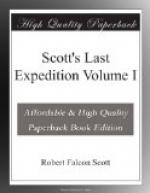So far so good. From a dangerous position we have achieved one which only directly involved a waste of coal. The question is, which will last longest, the gale or our temporary shelter?
Rennick has just obtained a sounding of 187 fathoms; taken in conjunction with yesterday’s 1111 fathoms and Ross’s sounding of 180, this is interesting, showing the rapid gradient of the continental shelf. Nelson is going to put over the 8 feet Agassiz trawl.
Unfortunately we could not clear the line for the trawl—it is stowed under the fodder. A light dredge was tried on a small manilla line—very little result. First the weights were insufficient to carry it to the bottom; a second time, with more weight and line, it seems to have touched for a very short time only; there was little of value in the catch, but the biologists are learning the difficulties of the situation.
Evening.—Our protection grew less as the day advanced but saved us much from the heavy swell. At 8 P.M. we started to steam west to gain fresh protection, there being signs of pack to south and west; the swell is again diminishing. The wind which started south yesterday has gone to S.S.W. (true), the main swell in from S.E. by S. or S.S.E. There seems to be another from south but none from the direction from which the wind is now blowing. The wind has been getting squally: now the squalls are lessening in force, the sky is clearing and we seem to be approaching the end of the blow. I trust it may be so and that the New Year will bring us better fortune than the old.
If so, it will be some pleasure to write 1910 for the last time.—Land oh!
At 10 P.M. to-night as the clouds lifted to the west a distant but splendid view of the great mountains was obtained. All were in sunshine; Sabine and Whewell were most conspicuous—the latter from this view is a beautiful sharp peak, as remarkable a landmark as Sabine itself. Mount Sabine was 110 miles away when we saw it. I believe we could have seen it at a distance of 30 or 40 miles farther—such is the wonderful clearness of the atmosphere.
Finis 1910
1911
Sunday, January 1.—Obs. 73 deg. 5’ S. 174 deg. 11’ E. Made good S. 48 W. 13.4; C. Crozier S. 15 W. 277’.—At 4 A.M. we proceeded, steaming slowly to the S.E. The wind having gone to the S.W. and fallen to force 3 as we cleared the ice, we headed into a short steep swell, and for some hours the ship pitched most uncomfortably.
At 8 A.M. the ship was clear of the ice and headed south with fore and aft sail set. She is lying easier on this course, but there is still a good deal of motion, and would be more if we attempted to increase speed.
Oates reports that the ponies are taking it pretty well.
Soon after 8 A.M. the sky cleared, and we have had brilliant sunshine throughout the day; the wind came from the N.W. this forenoon, but has dropped during the afternoon. We increased to 55 revolutions at 10 A.M. The swell is subsiding but not so quickly as I had expected.




